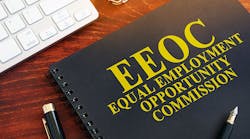Commentary & Analysis
Just as employers thought their long, confusing, years-long struggle to comply with changes in the Equal Employment Opportunity Commission’s EEO-1 form was finally coming to an end, a federal court judge has tossed a live grenade into the mix, creating massive uncertainty and confusion.
On March 4, Judge Tanya S. Chutkan of the U.S. District Court for the District of Columbia, an Obama appointee, vacated a 2017 order by the White House Office of Management Budget that had stayed the rule while its cost burdens were revaluated and new requirements developed. As a result of the judge’s action, the formerly defunct, highly complex EEO-1 form developed by the Obama-era EEOC is now in force.
Before Chutkan’s ruling, employers were expected to file the newer EEO-1 forms by May 31, a deadline that had been postponed due to the partial government shutdown earlier this year. As of March 5, the portal had yet to be opened to receive EEO-1 data that, until the judge’s decision, would have been much more limited than what was required by the Obama EEOC.
Of course, Chutkan’s ruling may very well be stayed while her ruling is appealed by the administration, which is expected to happen. The eventual reversal of the decision also is not unlikely—her 41-page decision reads more like a friend-of-the-court brief filed by a legal ally of the plaintiff, the National Women’s Law Center, than it does a judicious and fair review of the case.
The confusion she created is real. “It is unclear at this point if the 2018 reporting will require employers to include W-2 wage and hours worked data based on this ruling,” notes attorney Arthur Tacchino, chief innovation officer at SyncStream Solutions, a supplier of compliance solutions for employers. “It is possible that the EEOC could require these data points for the upcoming reporting cycle. If this is the case, it’s likely EEOC will push back the May 31 deadline for employers.”
Required under federal civil rights law in one version or another for more than 50 years, the EEO-1 form is an annual survey that must be filed with EEOC by all private employers with 100 or more employees. Also required to file are federal government contractors and first-tier subcontractors with 50 or more employees and a federal contract, subcontract, or purchase order amounting to $50,000.
Under the requirements adopted in 2016 by the Obama EEOC that have been reinstated by the judge, employers are expected to supply W-2 form income data for the number of employees in each of 10 different detailed job categories. Employers then must take that data and categorize their employees’ compensation in 12 different annual pay amounts organized into bands, ranging from about $19,000 to more than $208,000.
The Trump-era EEOC dialed back the more onerous of these requirements. At the crux of the reasoning was the vast difference between estimates of compliance costs for employers made by business associations, and the much lower costs the Obama commission came up with.
EEOC estimated the total compliance burden on employers would come in at no more than $53.5 million and 1.9 million hours per year. The U.S. Chamber of Commerce and others said that figure was grossly understated. A survey of employers conducted by the Chamber in 2016 showed the actual cost would include more than $400 million in labor costs alone, and would add up to a total cost burden of $1.3 billion a year for employers.
The Trump administration officials sided with the employers, pulling the rules back because the new EEO-1 process was found to be too burdensome. In her decision, Judge Chutkan belittled the administration’s employer cost concerns, choosing to accept wholeheartedly EEOC’s unfounded and unrealistic cost estimates.
In the meantime, before further legal appeals can make their way through the courts, EEOC is expected to issue instructions on how employers should proceed with their EEO-1 filings… once the Web portal for submitting those filings finally opens for business.



